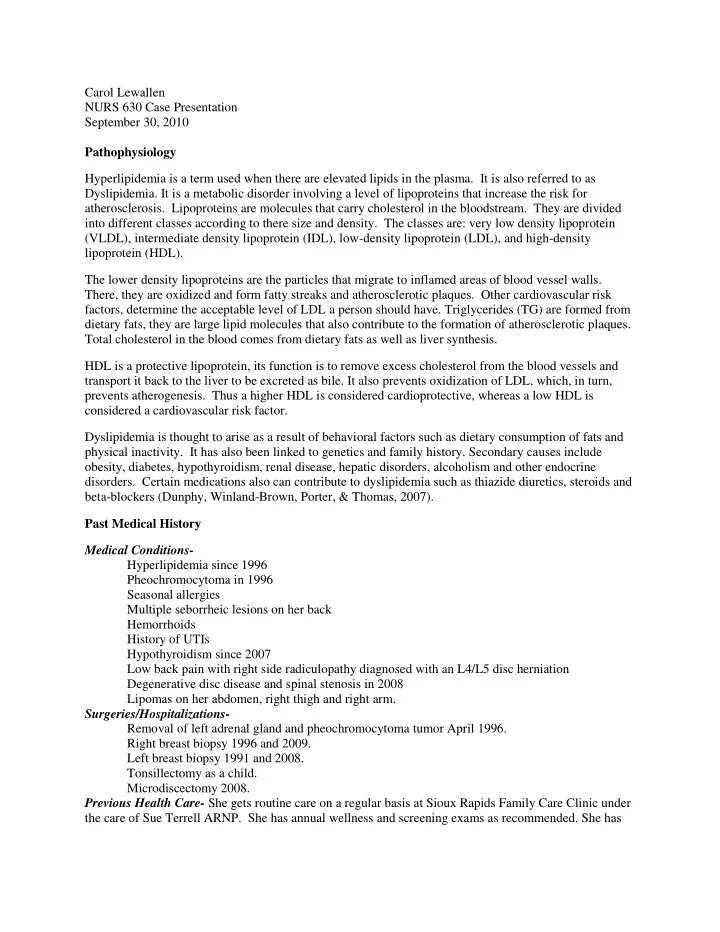

Carol Lewallen NURS 630 Case Presentation September 30, 2010 Pathophysiology Hyperlipidemia is a term used when there are elevated lipids in the plasma. It is also referred to as Dyslipidemia. It is a metabolic disorder involving a level of lipoproteins that increase the risk for atherosclerosis. Lipoproteins are molecules that carry cholesterol in the bloodstream. They are divided into different classes according to there size and density. The classes are: very low density lipoprotein (VLDL), intermediate density lipoprotein (IDL), low-density lipoprotein (LDL), and high-density lipoprotein (HDL). The lower density lipoproteins are the particles that migrate to inflamed areas of blood vessel walls. There, they are oxidized and form fatty streaks and atherosclerotic plaques. Other cardiovascular risk factors, determine the acceptable level of LDL a person should have. Triglycerides (TG) are formed from dietary fats, they are large lipid molecules that also contribute to the formation of atherosclerotic plaques. Total cholesterol in the blood comes from dietary fats as well as liver synthesis. HDL is a protective lipoprotein, its function is to remove excess cholesterol from the blood vessels and transport it back to the liver to be excreted as bile. It also prevents oxidization of LDL, which, in turn, prevents atherogenesis. Thus a higher HDL is considered cardioprotective, whereas a low HDL is considered a cardiovascular risk factor. Dyslipidemia is thought to arise as a result of behavioral factors such as dietary consumption of fats and physical inactivity. It has also been linked to genetics and family history. Secondary causes include obesity, diabetes, hypothyroidism, renal disease, hepatic disorders, alcoholism and other endocrine disorders. Certain medications also can contribute to dyslipidemia such as thiazide diuretics, steroids and beta-blockers (Dunphy, Winland-Brown, Porter, & Thomas, 2007). Past Medical History Medical Conditions- Hyperlipidemia since 1996 Pheochromocytoma in 1996 Seasonal allergies Multiple seborrheic lesions on her back Hemorrhoids History of UTIs Hypothyroidism since 2007 Low back pain with right side radiculopathy diagnosed with an L4/L5 disc herniation Degenerative disc disease and spinal stenosis in 2008 Lipomas on her abdomen, right thigh and right arm. Surgeries/Hospitalizations- Removal of left adrenal gland and pheochromocytoma tumor April 1996. Right breast biopsy 1996 and 2009. Left breast biopsy 1991 and 2008. Tonsillectomy as a child. Microdiscectomy 2008. Previous Health Care- She gets routine care on a regular basis at Sioux Rapids Family Care Clinic under the care of Sue Terrell ARNP. She has annual wellness and screening exams as recommended. She has
been followed in the past at Rochester Mayo for her pheochromocytoma. She has not been seen there since 2007. Preventive Screenings- Last PAP test with CBE was 9/09, Last Mammogram 5/10, She had a screening colonoscopy in 2008. She has not had a Dexascan. Immunizations- Last Tdap 10/29/07, she has not had an influenza, pneumonia or shingles vaccine. Allergies- Normodyne caused bronchospasms Medications- Claritin PRN Calcium with vitamin D 600mg daily Synthroid 0.075mg daily Simvastatin 80mg daily ASA 81mg daily Fish Oil 1000mg twice a day Preparation H to hemorrhoids PRN. Social/Personal History: Married white female who lives on a farm with her husband. Her life has been spent on the farm as a housewife and partner on the farm. They raise livestock on their farm where she is an active participant in the feeding and handling of the animals. She smokes about ½ a pack of cigarettes per day, uses no alcohol and drinks 4 cups of decaffeinated coffee each day. She is active in the Lutheran Church. She has no regular exercise program with her physical activities coming from her daily farm chores. Family History: Her father was deceased at age 71 with emphysema, her mother deceased at age 83 from “ old age ” . She was in good health prior to her death. She has 3 brothers alive and well with 1 brother deceased at age 47 from an MI. She has 2 sisters alive and well. Her paternal grandmother had breast CA at age 40 and she had a paternal cousin who also had breast CA. She has 2 daughters and 1 son each alive and well. Chief Complaint and HPI: This patient is seen at this visit for review of lab results and follow up of her hyperlipidemia and cholesterol lowering medication. Over the past 6 months, she had been having her cholesterol lowering medication adjusted. In February 2010, her lipids were elevated [I did not see these values]. Her Simvastatin was increased from 20mg daily to 40mg daily at that time. She returned in May 2010, at which time the lipid profile was still elevated and not at goal. Her Simvastatin was again increased to 80mg daily. Today she arrives at her visit and complains of muscle weakness and leg cramps. The leg cramps started in March 2010 and at that time were rare but since the beginning of summer, she has noticed them regularly along with feeling general muscle weakness. She stated that she does not feel as strong as she once was, noticing the weakness most when she is carrying heavy buckets of feed and water to the livestock on the farm. Activity worsens the leg cramps while rest relieves the leg pains. Review of systems: General: Denies fever, chills, weight changes, fatigue, night sweats, or sleep disturbances. HEENT: Denies visual changes, hearing loss, headaches, nasal congestion, ear pain, enlarged or tender lymph nodes in her neck. She states that she did have a cold about 2 weeks ago that included a sore throat that lasted for 2 days. Her last eye exam was in January 2010. Her last dental exam was in the summer of 2009.
Recommend
More recommend